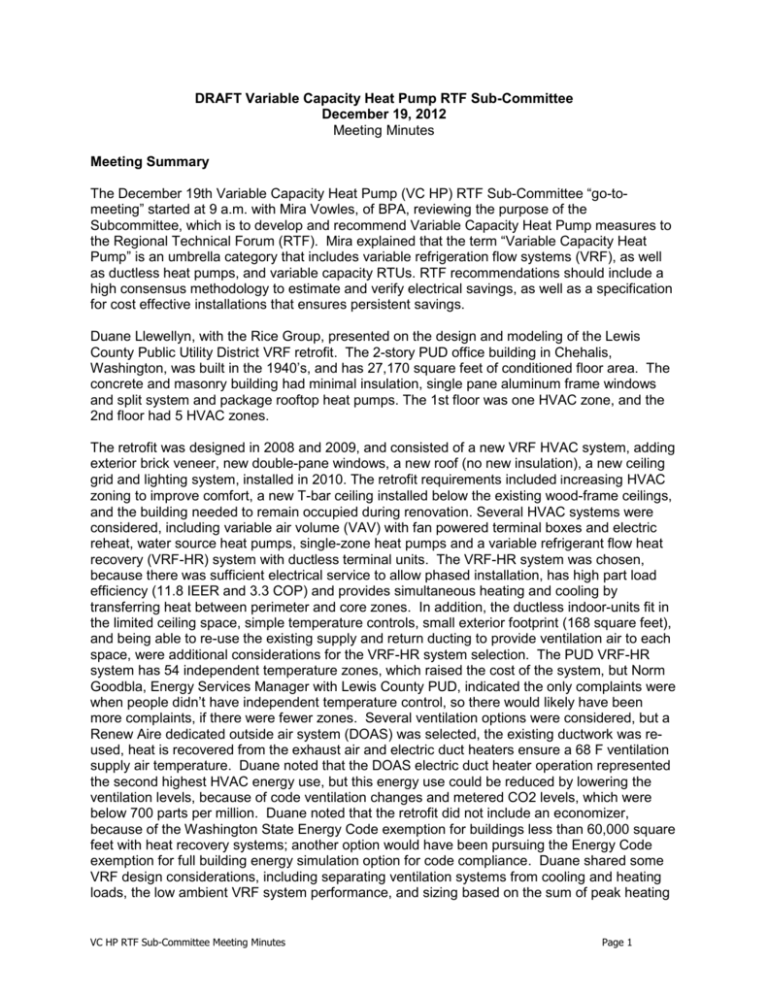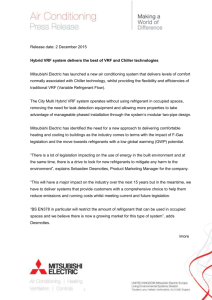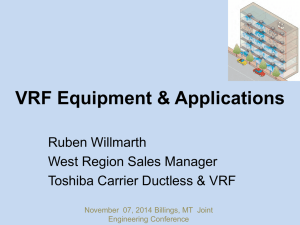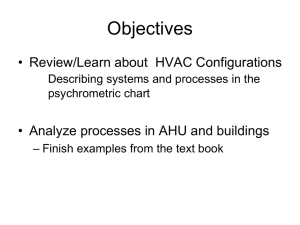Variable Capacity Heat Pump RTF Sub-Committee
advertisement

DRAFT Variable Capacity Heat Pump RTF Sub-Committee December 19, 2012 Meeting Minutes Meeting Summary The December 19th Variable Capacity Heat Pump (VC HP) RTF Sub-Committee “go-tomeeting” started at 9 a.m. with Mira Vowles, of BPA, reviewing the purpose of the Subcommittee, which is to develop and recommend Variable Capacity Heat Pump measures to the Regional Technical Forum (RTF). Mira explained that the term “Variable Capacity Heat Pump” is an umbrella category that includes variable refrigeration flow systems (VRF), as well as ductless heat pumps, and variable capacity RTUs. RTF recommendations should include a high consensus methodology to estimate and verify electrical savings, as well as a specification for cost effective installations that ensures persistent savings. Duane Llewellyn, with the Rice Group, presented on the design and modeling of the Lewis County Public Utility District VRF retrofit. The 2-story PUD office building in Chehalis, Washington, was built in the 1940’s, and has 27,170 square feet of conditioned floor area. The concrete and masonry building had minimal insulation, single pane aluminum frame windows and split system and package rooftop heat pumps. The 1st floor was one HVAC zone, and the 2nd floor had 5 HVAC zones. The retrofit was designed in 2008 and 2009, and consisted of a new VRF HVAC system, adding exterior brick veneer, new double-pane windows, a new roof (no new insulation), a new ceiling grid and lighting system, installed in 2010. The retrofit requirements included increasing HVAC zoning to improve comfort, a new T-bar ceiling installed below the existing wood-frame ceilings, and the building needed to remain occupied during renovation. Several HVAC systems were considered, including variable air volume (VAV) with fan powered terminal boxes and electric reheat, water source heat pumps, single-zone heat pumps and a variable refrigerant flow heat recovery (VRF-HR) system with ductless terminal units. The VRF-HR system was chosen, because there was sufficient electrical service to allow phased installation, has high part load efficiency (11.8 IEER and 3.3 COP) and provides simultaneous heating and cooling by transferring heat between perimeter and core zones. In addition, the ductless indoor-units fit in the limited ceiling space, simple temperature controls, small exterior footprint (168 square feet), and being able to re-use the existing supply and return ducting to provide ventilation air to each space, were additional considerations for the VRF-HR system selection. The PUD VRF-HR system has 54 independent temperature zones, which raised the cost of the system, but Norm Goodbla, Energy Services Manager with Lewis County PUD, indicated the only complaints were when people didn’t have independent temperature control, so there would likely have been more complaints, if there were fewer zones. Several ventilation options were considered, but a Renew Aire dedicated outside air system (DOAS) was selected, the existing ductwork was reused, heat is recovered from the exhaust air and electric duct heaters ensure a 68 F ventilation supply air temperature. Duane noted that the DOAS electric duct heater operation represented the second highest HVAC energy use, but this energy use could be reduced by lowering the ventilation levels, because of code ventilation changes and metered CO2 levels, which were below 700 parts per million. Duane noted that the retrofit did not include an economizer, because of the Washington State Energy Code exemption for buildings less than 60,000 square feet with heat recovery systems; another option would have been pursuing the Energy Code exemption for full building energy simulation option for code compliance. Duane shared some VRF design considerations, including separating ventilation systems from cooling and heating loads, the low ambient VRF system performance, and sizing based on the sum of peak heating VC HP RTF Sub-Committee Meeting Minutes Page 1 loads at winter design outdoor conditions. Routing condensate drainage from each of the indoor-units can be a challenge for retrofit projects. The Lewis County PUD system has integral indoor-unit condensate pumps, with 14 inches of lift. Duane noted that some retrofit projects may require supplemental condensate pumps that pump noise can be distracting and that condensate pumps above ceiling will be problematic in the long run. Also, the location of indoor-units is important for occupant comfort; wall-mounted indoor-units should be as high as possible and recessed ceiling indoor-units should not directly above people. Three options were considered for the Lewis County PUD system, including 1) a DDC control system, either from the VRF manufacturer, or communicating through an BACnet and LonWorks interface, 2) an input or output control board for the DOAS system, or pumps, fans, lighting and other loads, and 3) a tenant billing system with Watt-hour meters on the VRF outdoor-unit. Mira pointed out that these options were not selected because of the significant costs. Duane discussed how this project was selected for EPRI’s (Electric Power Research Institute) VRF Energy Efficiency Demonstration in 2011, sponsored by BPA and hosted by Lewis County PUD. Duane provided computer energy modeling to estimate VRF savings, as well as installing metering equipment to assess VRF and DOAS system performance. The EnergyPro model (version 5.1) estimated that the VRF system would use 20% less energy than conventional, split-system heat pumps with economizers, and Duane noted that while Ron Domitrovic, with EPRI, would talk more about the savings, but that 50% of the expected savings come from reductions in fan energy use, and that simultaneous heating and cooling was predicted to occur an average of 1,600 hours per year. Duane also summarized the metering equipment, which was installed in July of 2011, and included circuit level metering of the VRF system indoor and outdoor units, DOAS fan and electric duct heater. Outside air and indoor temperatures and humidity levels, as well as indoor CO2 levels were metered. Ron Domitrovic, with EPRI, described the VRF Energy Efficiency Demonstration project, which consisted of an Alabama site (ASHRAE climate zone A), two Tennessee sites (ASHRAE climate zone B) and the Lewis County PUD site. The Alabama project was the only one with good baseline data, and it showed 25 to 47% monthly HVAC savings. The Lewis County PUD project did not have baseline data, so an EnergyPro model was used for comparison; the model showed 14 to 27% monthly HVAC savings. However, the monthly modeled estimates varied between -12 and 32% of the metered VRF system energy use, with these large variations, it may not be meaningful to compare the EnergyPro baseline model and the metered VRF system energy use. In general, the EnergyPro baseline model over-estimated VRF-system cooling energy use and under-estimated VRF-system heating energy use. Some reasons for these discrepancies include: 10 degree modeled night setback, and 3 degree average actual night setback; different occupancy and load profiles; and TMY weather data and actual weather data. There was some discussion about night setback, especially during cold weather. Steve Fintak, a Mitsubishi representative, indicated that the City Multi has optimal start capability, and Duane noted that Washington State Energy Code requires optimal start, as well as HVAC energy submetering. Ron compared the modeled baseline (split-system heat pump) monthly fan energy use of 4,055 kWh (calculated by dividing the annual fan use by 12), to the metered January VRF indoor-unit and DOAS fan energy use of 1,770 kWh, and the metered August VRF indoor-unit and DOAS fan energy use of 2,379 kWh. Ron stated that the actual VRF fan energy use was very close to modeled, and that the VRF system fan energy use was about half of the modeled baseline fan energy use. Mira asked whether the VRF indoor-unit fans ran continuously (24/7), ramping up and down to meet loads, and whether that was true for most VRF installations. The general VC HP RTF Sub-Committee Meeting Minutes Page 2 consensus was that VRF indoor-unit fans run continuously to ensure accurate space temperature sensing and control. Next, Ron showed CO2 levels for one week in November, which were below 700 parts per million. The possibility to reduce the amount of ventilation was discussed as a possible energy efficiency measure. Finally, Mira summarized the responses for 2013 meeting times, which showed 100% availability for the 4th Wednesday at 10 am. Since there wasn’t time to discuss the Lewis County PUD project results, it was suggested that the meeting time be extended to 90 minutes, to allow time for discussion. So, the next VC HP meeting will be January 23rd from 10 am to 11:30 am. The topics for this meeting will include Brian Thornton, with PNNL, discussing a GSA VRF report, Energy Solutions discussing Baseline RTU fan energy use, and Ron discussing Lewis County PUD project results. The December 19th VC HP RTF Sub-Committee “go-to-meeting” adjourned at 10:08 a.m. Attendees: VC HP RTF Sub-Committee Meeting Minutes Page 3











